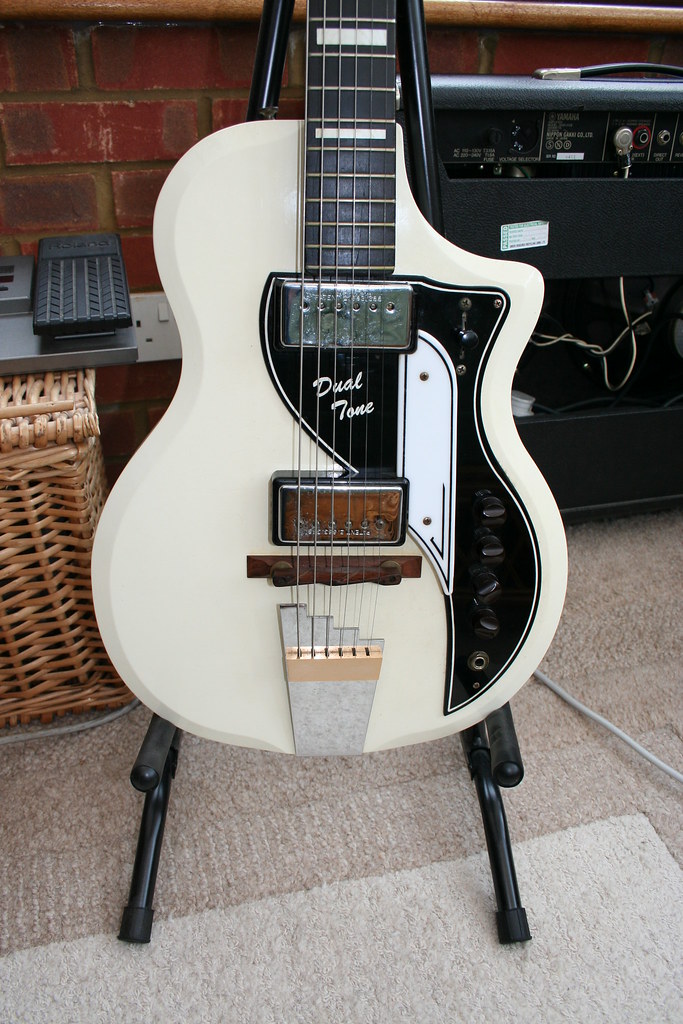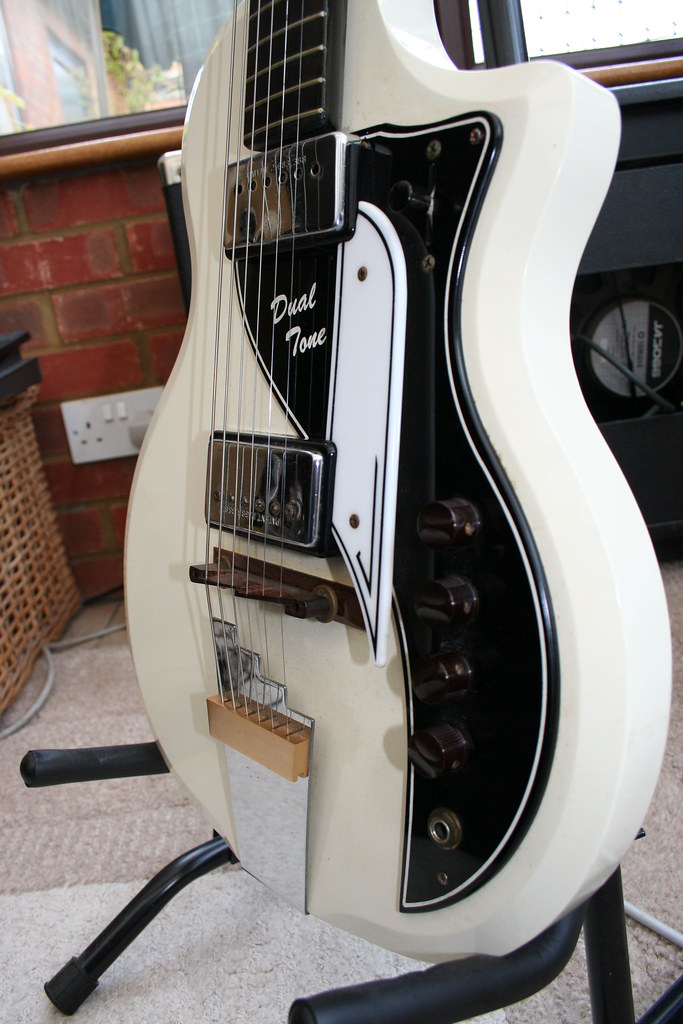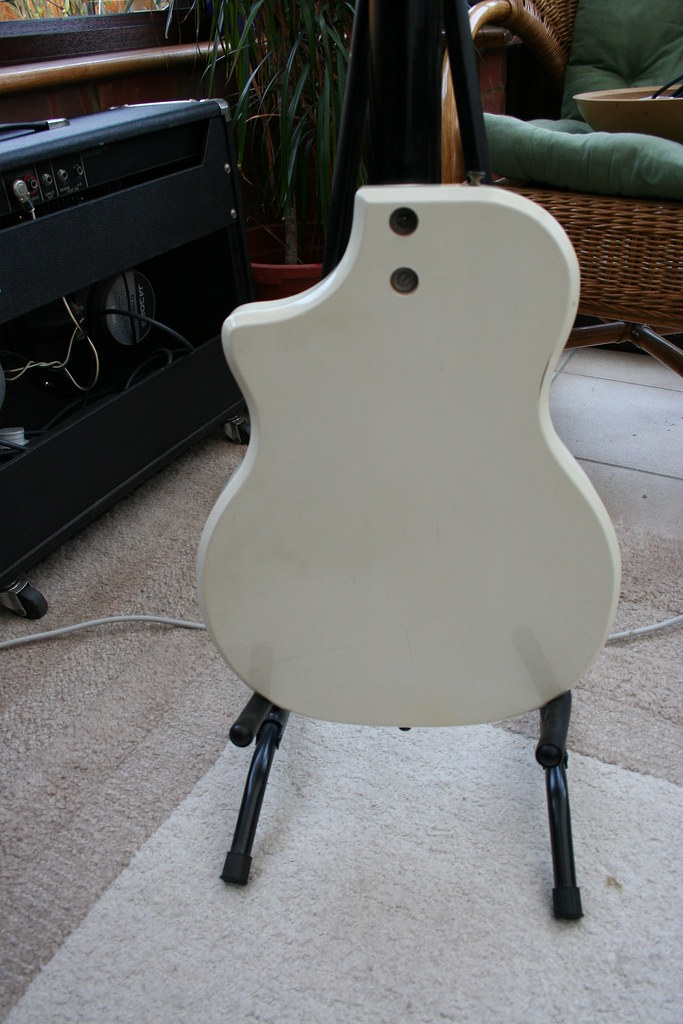Been trying to get some information about this Supro Dualtone.
The best place to find information on Valco guitars:
The Valco pages:
www.valcopages.com...and the associated Valco forum:
www.kilback.net/cgi-bin/ikonboard.cgiIf you're on Facebook, I am one of the administrators of the Valco Guitars page there:
www.facebook.com/pages/Valco-Guitars/49418833986Not much info about Supro on the interweb... And they seemed to change radically every year - Rainer Ptacek's 1964 Supro Dualtone, for example bears little relation to my instrument (apart from the pickups??).
The Dual-Tone (along with most Valco guitars) underwent some changes over the years. It started out with a much smaller body, expanded from 11.25" wide to 13.5" wide over a 5 year period after its mid-50s introduction, then switched to a fiberglass body in '62/'63.
That is the version that you see Rainer Ptacek playing.
I had a wooden '57 Dual-Tone and currently own a fiberglass '66 Dual-Tone (as well as several other Valco guitars, a '65 Martinique, a '65 Folkstar, a '64 English Electronics Tonemaster, and a wood bodied '59 Supro Rhythm-Tone...and a growing pile of Valco amplifiers)...they are very different animals in terms of both feel and tone.
The wood bodied Valco electrics had bodies made of basswood. Totally dead, with a resonant frequency outside of the guitar's range. You'd think they'd sound terrible, but amplified they simply sing. Likewise, you would not expect a superfluous tone from a hollow fiberglass body with some scrap wood inside. Contrary to all principles of guitar design, they sound outrageously good, most likely on account of the huge magnesium core of the necks. The neck bolts go right into that metal core, not the wood. It is safe to say that there's more metal than wood in those necks - they're like a giant metal bar veneered with a thin C-shaped wooden shell. Tension-free necks are starting to get some attention among guitar builders, but Valco was doing it almost 60 years ago.
This illustration of a snapped Valco neck should give a clearer explanation of what I'm talking about:

As you can see, there's barely any wood there!
The 50s necks tend to be narrow and clubby, I don't find them as comfortable as the somewhat wider 60s necks, although by then Valco was using a "zero fret" and that is a turn-off to some people. My preference is definitely for the wider 60s necks, specifically the bound necks with block markers. Valco also used unbound dot necks and they feel noticeably cheaper and less comfortable.
I found this picture of Link Wray playing a similar Supro Dualtone instrument
Link Wray went through a few of them (early Cadence Records promo pics show him playing a Dual-Tone like the one in the catalog scan above, later live shots show him playing one more similar to yours, wider body, plastic headstock logo, probably a '61 or '62 version. A good chunk of Link's Swan Records stuff from the early to mid 60s features the Dual-Tone. Once you are familiar with the sound, it is very easy to recognize.
Only difference is that the catalogue shows one with golden plated parts - mine has a gold bit on the tailpiece, but everything else is chrome.
The Dual-Tone was illustrated with gold hardware up until the 1960 catalog, but I am quite certain the change actually took place earlier and that the catalog pic simply was not updated.

By '63 the Dual-Tone had a fiberglass body (Res-o-glas, according to Valco's sales literature) and looked like this:

Dualtones (as you probably know) have a 'three-way' selector switch that cuts the power ( on its bottom setting) and increases the treble to the bridge pickup (a sort of 50s coil tap effect).
The rear position is actually the bridge pickup through a massive low frequency cut. Stripped of the lows, the signal appears very thin and quiet. A coil tap effect would not be possible on a single-coil pickup, and the Valco pickups, in spite of their appearance, are single-coils (they were not only available several years before Gibson's similar looking humbuckers, they are specifically mentioned in Gibson's patent application).
On some Valco electrics, while the neck pickup had a conventional tone control, the bridge pickup sometimes had a "bass cut" pot, instead of rolling off highs like a conventional tone control, it would roll off the lows, at its full setting it would produce a thin quiet tone similar to the rear switch position of your Dual-Tone.
My Dual-Tone does not have this feature, but on my Martinique it allows you to get very convincing Mosrite, P-90, and Telecaster sounds out of the bridge pickup, depending on how much of the lows you dial out with the knob.
The reason you do not have need of a truss rod is because Valco developed a bolt-on heel-less neck in 1948 which they called a 'Stylist' neck. By 1958, they were calling it a 'Kord-King' neck. Basically, the neck is a solid aluminium neck wrapped in wood and plastic. I suppose you could say the whole neck is a truss rod! It couldn't bend if it tried!
This is not altogether true, as evidenced by the large number of less-than-perfectly-straight Valco necks I have had in my hands. The most common way that they get trashed is when an uninformed new owner assumes that the "tilt adjustment" screw is a neck bolt, and torques it as hard as they can (without loosening the actual neck bolt first).
That wooden Dual Tone has ONE neck bolt - the second one is a tilt adjustment screw. Yes, the neck is being held on with ONE screw! The fiberglass versions used two screws and a tilt adjustment in the middle.
Since I had it popped open today in order to resolve a grounding issue (a previous owner had made some rather boneheaded "repairs" to the wiring), here are some photos of my '66:


What exactly is the three way switch doing? A mixture of gain and pickup phase switching?
In the 'quiet' forward position, only the neck pickup seems to be active
Switch towards the neck: neck pickup
Switch in the middle: bridge pickup
Switch towards the bridge: bridge pickup w/ all the bass dialed out
If you want to combine pickups, you'll need to "balance" your switch between the neck and middle settings, the way people did with 3-way strat switches.
If your NECK pickup seems quieter (usually the opposite is true), you should raise it. These pickups have virtually no magnetic pull, so setting them as close as possible to the strings where they sound their best doesn't cause any intonation/magnetic pull issues.
The pickups are height adjustable, although most people don't realize it. The outside (E string) polepieces raise or lower the pickup itself, then use the remaining 4 polepieces to balance it out from string to string.































